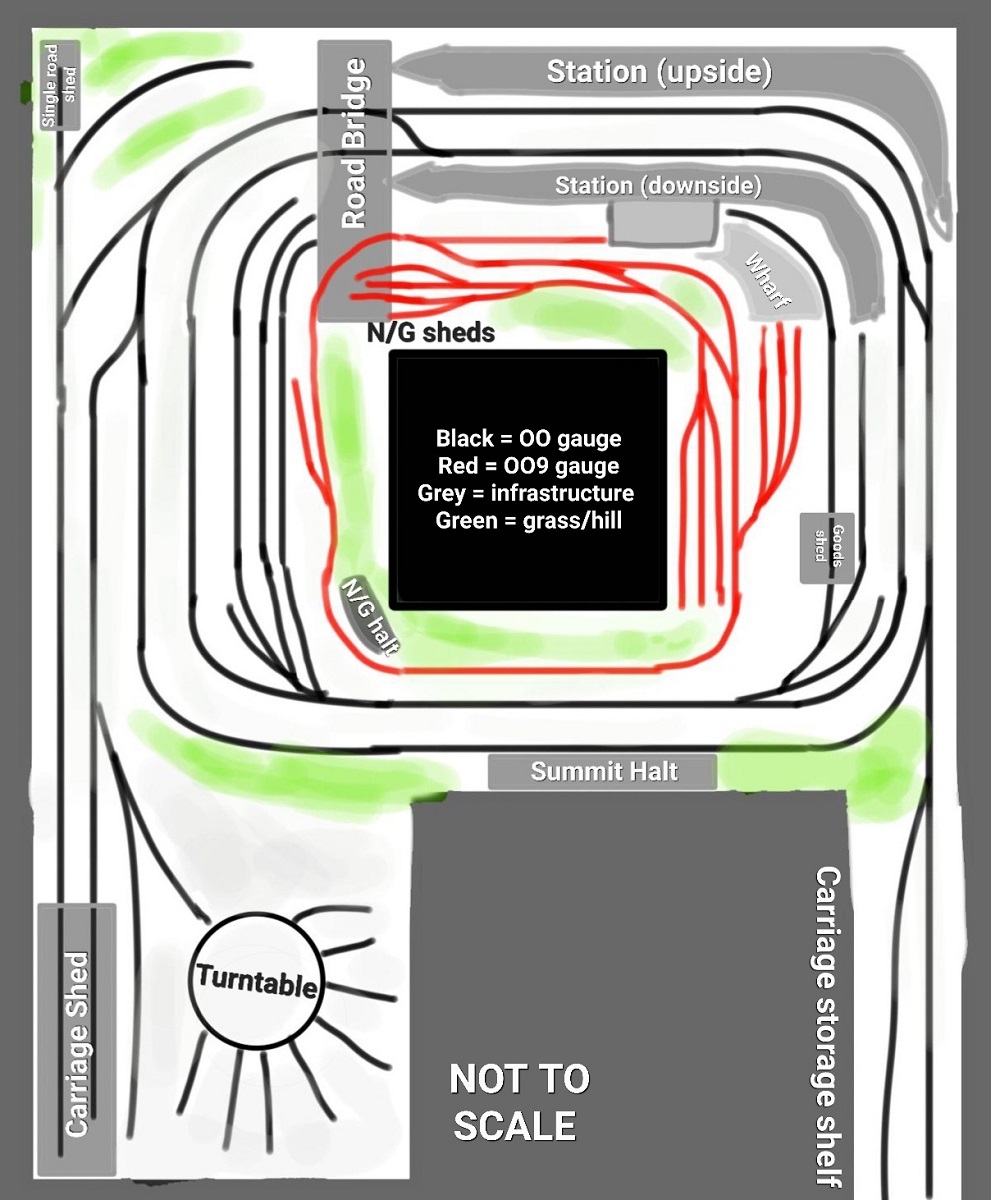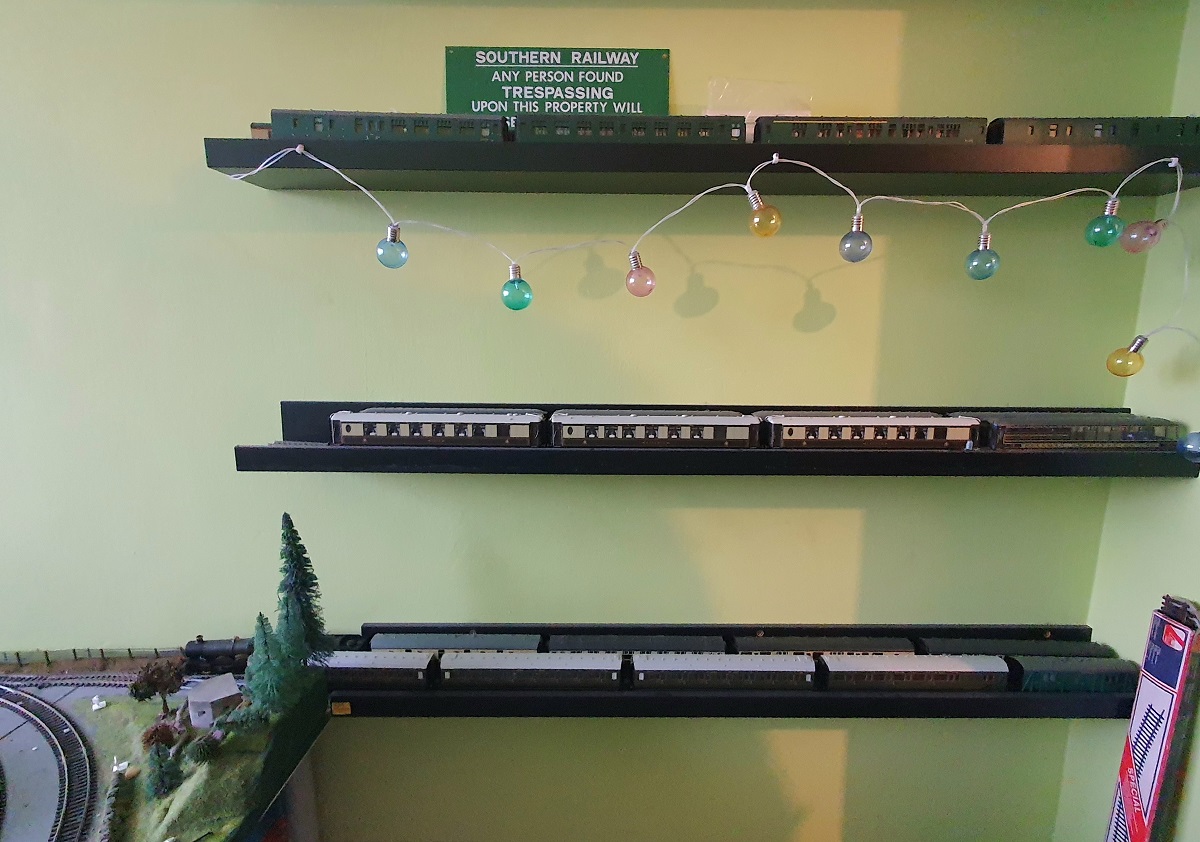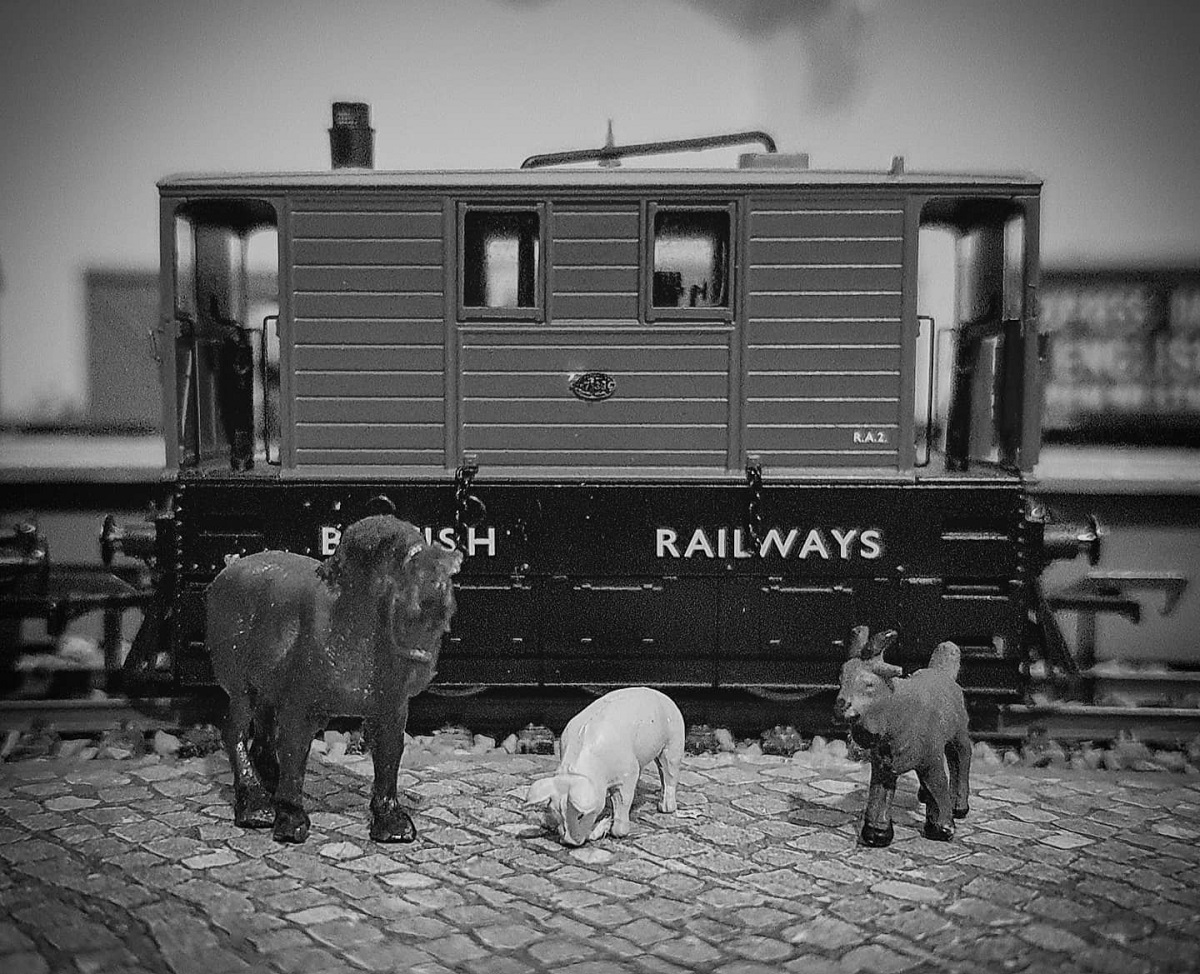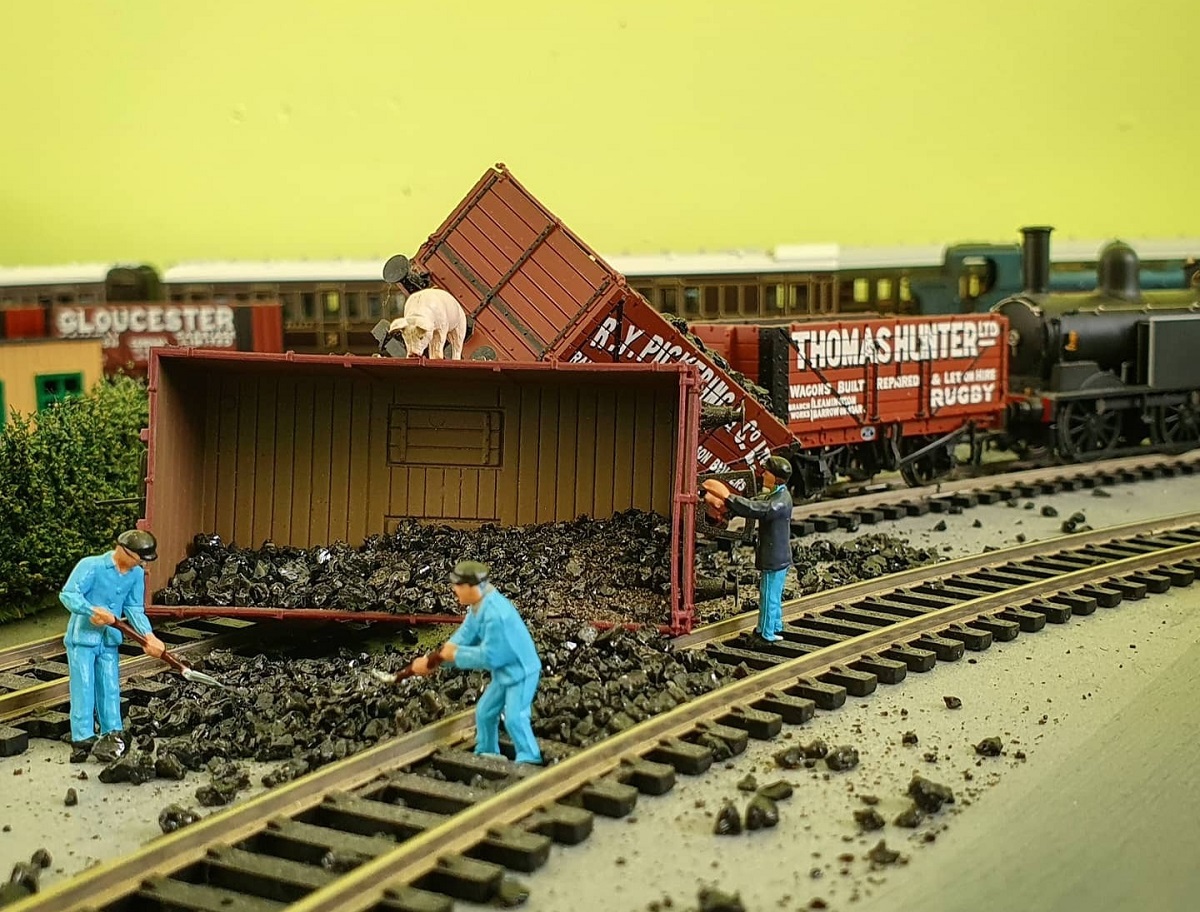UK Based Preservation Era Layout
- Layout name: Another Model Railway
- Built by: Jago Curnow
- Type: Tabletop layout
- Dimensions: 83 x 79 in (210 x 200 cm)
- Scale: OO
- Country: United Kingdom
- Epoch: Preservation era

Hi! Tell us about yourself and how you got into model trains
Hello all. My name is Jago Curnow, although those of you who know of my Instagram account will think of me as the 1:76 scale swine that resides on my layout, Malcolm Cumberland; but we’ll get to him a little later.
Based in the south of England, by day I work with a local taxi firm. Not on the roads, but in the background helping the fleet and system work as it should, fitting vehicles with equipment and helping to ensure the smooth running of the business.
Now 24 years old, I started ‘playing trains’ quite young thanks to my grandfather’s lifelong passion for steam locomotives passed down through the generations along with the influence of a certain blue tank engine. Some of my earliest memories are up in his attic. A single lightbulb flickering on the roof, boxes full of household things in each corner and the whirring and buzzing of a little Triang model making its way around the perimeter, making a warm dusty smell fill the room. Memories I feel a lot of us can relate to.
I had always been more of a collector and operator when it comes to model railways, from the age of three to present day, however in more recent times, I have taken to altering and rebuilding ready-to-run models into locomotives not available in the market.
I find great joy in making something unique and can get lost in the inner mechanicals of different models, even if the final outcome isn’t perfect. A fact that my very patient girlfriend very graciously helps me with, but along with the modeling I’m also a landscape/railway photographer and folk musician – amateur for both of course.
I find the railway modelling to be the most satisfying however, mainly due to the freedom of choice it gives you. Obviously, there’s historical and prototypical accuracy to work within, but your creation is bound only by your imagination and the limitations you set yourself.
Please describe your layout
My layout isn’t set anywhere in particular, no specific time or era, just simply whatever I choose it to be. The easiest way to describe it would be somewhere in the UK, set in preservation era. This way I can use whichever loco, with whatever rolling stock passing any station style, without being too worried about accuracy.
This layout is technically the mark three. Mark one was a simple base board which I would keep behind the sofa back when I was a child. Mark two was a loft layout I progressed to as a teenager, which, due to confines of space, was in a triangle shape using mainly radius 1 or 2 curves so only smaller engines could run. Then when the family moved house, the modelling stopped. Everything was ripped up, boxed up and forgotten about while we didn’t have the space for a layout and I was busy with other things.
Then, four years ago, having gotten my own place, I was able to spare the time and space where the mark three was created. A simple 2000 x 2100 mm perimeter layout, with enough room for me to sit in the middle and control everything.
There are two railways on this layout, a standard gauge OO railway with a narrow gauge OO9 twisting and turning within it. The main hub of the layout being a large station and transfer sidings where the two gauges meet at a wharf style yard. Heading clockwise, the mainline then heads up a ‘Lickey incline’ style gradient towards a halt and disused signal box at the summit. Heading back downhill, past the carriage sidings and loco yard, before passing below road bridge arriving back at the main station.
Other aspects had been added on since the main circuit was made, including an open turntable yard at the summit, a junction which leads off to more carriage storage, and a narrow gauge shed area created beneath the road bridge. Nothing on this layout has truly been built by myself. Everything has either been bought complete, or edited to fit its surroundings before placement.
This is something I’d like to change, and scratch building is something I’d certainly like to start experimenting with. I think next time, I would to use flexi-track rather than set track from Hornby or Peco. The ‘square’ nature of the set track does rather affect the realism of the line.
The name of a layout is another thing I need to work on. I’ve always found it difficult when naming my glorified train sets. Names are important, they hold meaning and present expectations when being introduced and I always found it hard to think of something between being too boring or too pretentious. This is why, when I started the Instagram, I simply named it Another Model Railway – exactly what it is. Eventually I’ll get round to thinking of an area or some station names, maybe somewhere in the West country.
There are certain aspects of the line that I’m quite proud of, such as my carriage storage at the summit of the line. Disguised at surface level by some hills and trees, the line junctions off into an embankment and on to a connected shelf where there is a double tracked meter long storage line. There are four of these layered on top of each other, which are actually IKEA vinyl record shelves. They’re the perfect width for two tracks and length to hold four carriages.
It’s aspects like this however which make the layout permanently in place at home. I do have some smaller layouts currently half-finished which I would ultimately like to exhibit, but all in good time.
How did you plan your layout?
When it came to making the layout, I was rather confined by the usual two parameters: space and budget. I was starting with some left over baseboards from previous projects and a box full of assorted track pieces, both in OO and OO9. I rather haphazardly measured and cut the wood to shape, leaving ample space in the middle for me to reach each corner, then quite simply started putting track pieces together.
I didn’t use any computer program or even scribble any rough designs on paper. I used what I had to create a basic, double tracked circuit, then did the same to create a smaller single track line for the narrow gauge. Once this was all in place, I started mapping out sidings and basic infrastructure on the base board with a pencil.
I completed what I could with what I had at the time, then spent the remainder of that year buying what else I needed to complete my vision. This way I didn’t have to work to much of a budget. I already had the locos, the rolling stock with a few buildings and set track from previous builds, so it was just a matter of putting these all together and building on top of that in the following months / years.
The layout has steadily grown since. It would have been nice to use some sort of design program to develop the line a little quicker as I would end up replacing and relaying almost every corner of the layout at some point since. But I feel that’s all part of it. It’s good to keep things open to change just in case a better idea comes to mind. That’s part of the reason why I still haven’t ballasted the mainline, I’m still not 100% certain whether I’m going to change anything.
During the building process, I came to the idea of starting an Instagram, more as a joke than anything else, but ultimately to record the progress of detailing. From this I made up a little character called Malcolm Cumberland. A rather blunt, cheeky OO gauge Bachmann pig who has rather become the face of the layout. Any major changes to the line, or big announcements to make, this little swine is there to give the news.
The idea was to make regular videos with him to show progress or just to be silly, however as I’m sure many of you know, video making is a long and monotonous process which I never seemed to have enough time to fully engross myself in but I will get back into at some point.
Describe your rolling stock
The rolling stock is most definitely my favorite part of the layout. As a steam enthusiast, the locomotives I collect are the beating heart of my layout, all with different stories to tell, whether it be how I came to acquire the model, or the real life counterparts significance.
All of my locomotives are currently running on analogue and I don’t have any plans to DCC fit any of them any time soon. DCC is very impressive and the sound model are very interesting, but I love the endless playability of an analogue layout. All of my points are still manual and not many of my sidings are isolated other than the plastic frog points, so shunting really makes you think about loco placement and how to position everything as if it were one big big puzzle.
Generally I like to have a range of stock on the line. I’ve got a rake of carriages from each of the big four railway companies in Britain, along with a few pre-grouping examples including a rake of 4 wheel SECR coaches which I made from some cut down clerestory coaches.
Most of the standard gauge stock is from the usual companies, whereas the narrow gauge is from a mixture of PECO, Bachmann and more commonly 3D prints and kit builds as well as a few kit-bashes I’ve made from broken models found on eBay and local model shops.
I find most brands to have their strong points, but as of the current models being produced, Bachmann would definitely be my favorite. Despite their flaws on models in the not too distant past, their current batch I feel show a good balance of mechanical and design value along with some of the best decoration quality of any brand out today.
Hornby of course has its merits and usually produces a quality model, but with the likes of Rapido of Dapol improving with each model they produce, I’m looking forward to see how the big hobby suppliers change to complete with an ever growing market.
Back to my trains though, the majority of my fleet are as bought, maybe with a few additions like lamps or light weathering. A fair few have been renumbered to represent preserved models, the first being a BR green ‘Mallard’ which I renumbered into preserved sister locomotive no. 60009 ‘Union of South Africa’, which at the time was in its last year of service.
In the last few years however, I’ve started building and modifying my own locomotives. The most prominent being a DJ Models Austerity tank which I converted to represent the Mid Hants Railway’s ‘Day out with Thomas’ locomotive which itself was converted from a preserved J94 Austerity tank.
Other projects I’ve done include simple repaints and livery changes for example creating a BR red 8F, similar to that from the Great Central Railway, to more larger work such as modifying a Bachmann Fowler 3F to a fictitious SDJR 3F mogul or building LSWR T3 locomotive from a Hornby Adams Radial tank; both being much bigger jobs than I initially expected.
Overall, I think my favorite locos on the line are my narrow gauge engines. Most of them have so much detail and really evoke the character of the real little engines. Once again, Bachmann rather set the standard with their Baldwin locos, really moving the gauge on from the likes of the rather basic Minitrains models.
Peco also bringing out decent models, with their OO9 George England locos, and despite the mechanical infidelities, Heljan’s L&B Manning Wardles remain to be some of the most detailed models I own. I’m really excited to see where the OO9 will go next. Wondering which companies will start creating narrow gauge and whether some budget / lower cost models will be created to allow newcomers to get into this still rather niche gauge.
Advice for other people in the model train world
When it comes to starting out in model railways, the cost is probably the most daunting thing which you can face. With brand new models costing anywhere from £90 to £250 and rolling stock not costing a lot less, I’d definitely recommend finding some second hand models to start off with.
The best advice I could give would be to find your nearest model shop. Too many people automatically look online to buy their models, but if you can, I’d highly recommend finding somewhere a little closer to home. They can provide a wealth of knowledge towards starting out and progressing in the hobby, with the majority having a wealth of information and experience to learn from. They can also often supply a lot more reasonably priced models, controllers and track types needed than the basic ovals provided by starter sets from the likes of Hornby.
When I first started with this mark three layout, the most is spent was £85 on a Hornby HM2000 feedback controller. While not the best controller on the market, it certainly was the best purchase I made when restarting the hobby. It makes all the difference when you progress from a standard train set controller to something a little more specialized.
As someone reintroducing themselves into the hobby rather than starting anew, I found it a lot more progressive to think of the layout as a real place rather than a collection of models. This way you’re able to advance the realism of the railway which will only add to the impressiveness to the end product.
A model layout is exactly what you want to make it. It doesn’t have to be an accurate representation of real world locations. Like with any hobby, you are only bound by the limits of your imagination and there is no right and wrong as to what you make. So long as the electronics are kept safe and we respect what other members of the hobby want to create, then you are free to create exactly what you want.
Probably the best advice I have received about railway modelling is to be patient with what you want. You don’t need to have the newest most expensive models to create a detailed realistic layout and more often than not you can always find an alternative to the expensive options.
You also don’t need to have a definitive plan in place when designing the layout. Don’t feel pressured by the pursuit of progress to complete everything. Let it grow naturally and it will feel a lot more ‘lived in’ and part of the landscape you create rather than just a trainset on a flat top table.
The fun is in the progression and thinking through the dynamics of the landscape. Really making it feel believed in and allowing you to surround yourself in the escapism the hobby provides.


















